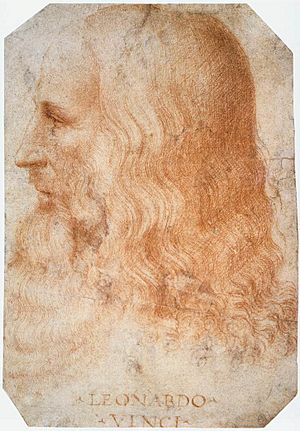Renaissance man facts for kids
The term Renaissance man or polymath describes someone super smart who is great at many different things. Imagine a person who is an amazing artist, a brilliant scientist, and a clever inventor all at once! This idea comes from a special time in history called the Renaissance, which happened between about 1400 and 1600.
One of the most famous "Renaissance men" was Leonardo da Vinci. He was best known as a painter, but he was also a fantastic scientist, engineer, and mathematician. Another famous "Renaissance man" was Michelangelo, who was a wonderful sculptor, painter, architect, and poet.
When we use the term "Renaissance man," it doesn't always mean the person lived during the Renaissance period. It can describe anyone who is very clever and skilled in many different areas, no matter when they lived. For example, Albert Schweitzer was a 20th-century "Renaissance man" who was a theologian, musician, philosopher, and doctor. Benjamin Franklin was an 18th-century "Renaissance man" who was an author, printer, politician, scientist, inventor, and soldier.
Contents
Amazing People Who Did It All
Many incredible individuals throughout history have shown skills in many different fields, just like the original Renaissance men. Here are a few examples:
Ancient World Geniuses
Aristotle: The Greek Thinker
- Aristotle (384 BC – 322 BC) was a Greek philosopher. He studied and wrote about many subjects, including how the world works (physics), poetry, music, how we think (logic), politics, and even biology. He was one of the first to use scientific thinking.
Archimedes: Master of Machines
- Archimedes (around 287 BC – 212 BC) was a Greek mathematician, physicist, engineer, inventor, and astronomer. He invented many clever machines and discovered important rules about how things float and how levers work.
Medieval and Renaissance Masters
Avicenna: The Persian Healer
- Abū Alī ibn Sīnā (980–1037) was a Persian physician and philosopher. He was also a mathematician, astronomer, chemist, and even a statesman. His medical books were used for hundreds of years.
Leonardo da Vinci: The Ultimate Polymath
- Leonardo da Vinci (1452–1519) was an Italian genius. He was a famous painter (think Mona Lisa), but also an engineer, astronomer, biologist, geologist, physicist, architect, musician, and philosopher. He designed flying machines and studied the human body in detail.
Michelangelo: Artist and Builder
- Michelangelo (1475 – 1564) was an Italian Renaissance artist. He was a painter, sculptor, architect, and poet. He created amazing works like the statue of David and painted the ceiling of the Sistine Chapel.
Galileo Galilei: Looking at the Stars
- Galileo Galilei (1564–1642) was an Italian scientist. He was a mathematician, astronomer, physicist, and philosopher. He made big improvements to the telescope and was one of the first to use it to study the sky, proving that the Earth goes around the Sun.
Modern Era All-Rounders
Isaac Newton: Laws of Motion
- Isaac Newton (1643–1727) was an English physicist and mathematician. He developed calculus (a type of math) and discovered his three laws of motion, which explain how things move. He also studied gravity.
Thomas Jefferson: American President and Inventor
- Thomas Jefferson (1743–1826) was an American president. He was also a gardener, architect, archaeologist, and inventor. He even founded a university!
Winston Churchill: Leader and Artist
- Sir Winston Churchill (1874 – 1965) was a British prime minister and military leader. He was also a historian, novelist, and painter. He led Britain during World War II.


